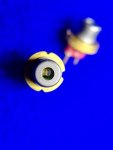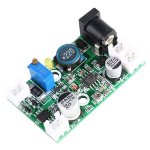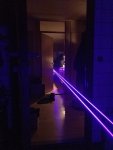- Joined
- Nov 11, 2014
- Messages
- 72
- Points
- 18
Got two questions..
I notice many members seems to run there diode in sinkhousing from bench-power supplies, when benchmarking there diodes.
Is this as straight as it appears.. Are an rookie on this field and not least electronics lab'ish equipment, but judging from the pictures it seems that an adjustable bench-power supply is sufficient as long as you dont floor it with to much current & voltage while adjust it according to LD spec-values with an eye on when it starts to dropped & tip over..
Jumped on a couple of model-unspecified cheap 445nm-diodes a year back from an ebay auction, and these two diodes just been sitting in the draw in lack of dummyload and generel equipment.
Finally optain a couple of Korad programmable bench-power-supplies there was on sale (KD3005P and KA3003P) and trying to get familiar with the handling and been testing with some plain 1*cent LEDs in numerous colors to sense when they shift/top and role/dropped back...(not that relevant in regards to LDs and the values varies a lot but still give some insigt into the handling of current & voltage for an rookie like me to sense charistica when tilting)
the other question was in regards to these unspecified diodes i ended up with, they where simply labeled 445nm laser diodes with around "1.4A in current-suggestion" in there sealed bags,- was an ebayauction and wondering what LDs-model they actually are' to get an ida of the specification I should run them at..
back then when i recived them, I checked the web, and afterwards was of the impression it either was some 5.6mm Osram +1w model or A-140 hence the low price i got them for' and there +/- pin schematic does look a lot like A140 and a short rubber-pin spacer..
Have checked DTR very informative-site, partically the datsheets on many relevant diodes and a picture walkthrue while testing effect is appreciated from here, but i cant see any detail or test, for A140 but judging from pictures online ' they certainly look a lot like A140.. I would estimate they are A-140 (pic attached bottom)
https://sites.google.com/site/dtrlpf/home/diodes/a140-445nm-diodes
was planning to put the voltage close to 4.8v and the current at 1500ma on the bench and see how much amp it consumes while up'ing the voltage to max 4.8v..
or will it be better to take an 12v TTL 405/445nm driver I allready got in house with adjustable drivercurrent and also adjustable drivervoltage (pic attached) and put that in between LD and bench supply' and adjusted the TTLdriver LD'out-port to 4.8v .. and with an max of 1500mah from the bench-suppl, while having the driver close to the lower current levels and then adjust the current forward from that while having an DMM attached to see what mA it takes from the driver to laserdiode..
I notice many members seems to run there diode in sinkhousing from bench-power supplies, when benchmarking there diodes.
Is this as straight as it appears.. Are an rookie on this field and not least electronics lab'ish equipment, but judging from the pictures it seems that an adjustable bench-power supply is sufficient as long as you dont floor it with to much current & voltage while adjust it according to LD spec-values with an eye on when it starts to dropped & tip over..
Jumped on a couple of model-unspecified cheap 445nm-diodes a year back from an ebay auction, and these two diodes just been sitting in the draw in lack of dummyload and generel equipment.
Finally optain a couple of Korad programmable bench-power-supplies there was on sale (KD3005P and KA3003P) and trying to get familiar with the handling and been testing with some plain 1*cent LEDs in numerous colors to sense when they shift/top and role/dropped back...(not that relevant in regards to LDs and the values varies a lot but still give some insigt into the handling of current & voltage for an rookie like me to sense charistica when tilting)
the other question was in regards to these unspecified diodes i ended up with, they where simply labeled 445nm laser diodes with around "1.4A in current-suggestion" in there sealed bags,- was an ebayauction and wondering what LDs-model they actually are' to get an ida of the specification I should run them at..
back then when i recived them, I checked the web, and afterwards was of the impression it either was some 5.6mm Osram +1w model or A-140 hence the low price i got them for' and there +/- pin schematic does look a lot like A140 and a short rubber-pin spacer..
Have checked DTR very informative-site, partically the datsheets on many relevant diodes and a picture walkthrue while testing effect is appreciated from here, but i cant see any detail or test, for A140 but judging from pictures online ' they certainly look a lot like A140.. I would estimate they are A-140 (pic attached bottom)
https://sites.google.com/site/dtrlpf/home/diodes/a140-445nm-diodes
was planning to put the voltage close to 4.8v and the current at 1500ma on the bench and see how much amp it consumes while up'ing the voltage to max 4.8v..
or will it be better to take an 12v TTL 405/445nm driver I allready got in house with adjustable drivercurrent and also adjustable drivervoltage (pic attached) and put that in between LD and bench supply' and adjusted the TTLdriver LD'out-port to 4.8v .. and with an max of 1500mah from the bench-suppl, while having the driver close to the lower current levels and then adjust the current forward from that while having an DMM attached to see what mA it takes from the driver to laserdiode..
Attachments
Last edited:

















































